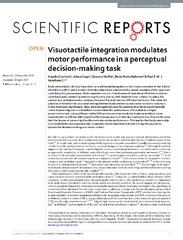Visuotactile integration modulates motor performance in a perceptual decision-making task
Аутори
Grechuta, KlaudiaGuga, Jelena

Maffei, Giovanni
Rubio Ballester, Belen
F. M. J. Verschure, Paul
Чланак у часопису (Објављена верзија)
Метаподаци
Приказ свих података о документуАпстракт
Body ownership is critically dependent on multimodal integration as for instance revealed in the Rubber Hand Illusion (RHI) and a number of studies which have addressed the neural correlates of the processes underlying this phenomenon. Both experimental and clinical research have shown that the structures underlying body ownership seem to significantly overlap with those of motor control including the parietal and ventral premotor cortices, Temporal Parietal Junction (TPJ) and the insula. This raises the question of whether this structural overlap between body ownership and motor control structures is of any functional significance. Here, we investigate the specific question of whether experimentally induced ownership over a virtual limb can modulate the performance of that limb in a simple sensorimotor task. Using a Virtual reality (VR) environment we modulate body ownership in three experimental conditions with respect to the (in)congruence of stimulus configurations. Our results sho...w that the degree of ownership directly modulates motor performance. This implies that body ownership is not exclusively a perceptual and/or subjective multimodal state but that it is tightly coupled to systems for decision-making and motor control.
Кључне речи:
Decision / human behavior / perception / sensory processingИзвор:
Scientific Reports, 2017, 7Издавач:
- London: Nature Publishing Group
Финансирање / пројекти:
- MINECO “Retos Investigacion tos Investigacion I + d + i”, Plan Nacional project, SANAR (Gobierno de Espan∽a) - under agreement TIN2013-44200-REC and also FPI grant nr. BES-2014-068791, European Research Council under grant agreement 341196 (CDAC), and “Excellence in Human Resources as a Source of Competitiveness” project (CZ.1.07/2.3.00/30.0013), OP Education for Competitiveness, funded by the European Social Fund in the Czech Republic and by the State Budget of the Czech Republic
URI
https://www.nature.com/articles/s41598-017-03488-0http://rifdt.instifdt.bg.ac.rs/123456789/2329
Колекције
Институција/група
IFDTTY - JOUR AU - Grechuta, Klaudia AU - Guga, Jelena AU - Maffei, Giovanni AU - Rubio Ballester, Belen AU - F. M. J. Verschure, Paul PY - 2017 UR - https://www.nature.com/articles/s41598-017-03488-0 UR - http://rifdt.instifdt.bg.ac.rs/123456789/2329 AB - Body ownership is critically dependent on multimodal integration as for instance revealed in the Rubber Hand Illusion (RHI) and a number of studies which have addressed the neural correlates of the processes underlying this phenomenon. Both experimental and clinical research have shown that the structures underlying body ownership seem to significantly overlap with those of motor control including the parietal and ventral premotor cortices, Temporal Parietal Junction (TPJ) and the insula. This raises the question of whether this structural overlap between body ownership and motor control structures is of any functional significance. Here, we investigate the specific question of whether experimentally induced ownership over a virtual limb can modulate the performance of that limb in a simple sensorimotor task. Using a Virtual reality (VR) environment we modulate body ownership in three experimental conditions with respect to the (in)congruence of stimulus configurations. Our results show that the degree of ownership directly modulates motor performance. This implies that body ownership is not exclusively a perceptual and/or subjective multimodal state but that it is tightly coupled to systems for decision-making and motor control. PB - London: Nature Publishing Group T2 - Scientific Reports T1 - Visuotactile integration modulates motor performance in a perceptual decision-making task VL - 7 DO - 10.1038/s41598-017-03488-0 ER -
@article{
author = "Grechuta, Klaudia and Guga, Jelena and Maffei, Giovanni and Rubio Ballester, Belen and F. M. J. Verschure, Paul",
year = "2017",
abstract = "Body ownership is critically dependent on multimodal integration as for instance revealed in the Rubber Hand Illusion (RHI) and a number of studies which have addressed the neural correlates of the processes underlying this phenomenon. Both experimental and clinical research have shown that the structures underlying body ownership seem to significantly overlap with those of motor control including the parietal and ventral premotor cortices, Temporal Parietal Junction (TPJ) and the insula. This raises the question of whether this structural overlap between body ownership and motor control structures is of any functional significance. Here, we investigate the specific question of whether experimentally induced ownership over a virtual limb can modulate the performance of that limb in a simple sensorimotor task. Using a Virtual reality (VR) environment we modulate body ownership in three experimental conditions with respect to the (in)congruence of stimulus configurations. Our results show that the degree of ownership directly modulates motor performance. This implies that body ownership is not exclusively a perceptual and/or subjective multimodal state but that it is tightly coupled to systems for decision-making and motor control.",
publisher = "London: Nature Publishing Group",
journal = "Scientific Reports",
title = "Visuotactile integration modulates motor performance in a perceptual decision-making task",
volume = "7",
doi = "10.1038/s41598-017-03488-0"
}
Grechuta, K., Guga, J., Maffei, G., Rubio Ballester, B.,& F. M. J. Verschure, P.. (2017). Visuotactile integration modulates motor performance in a perceptual decision-making task. in Scientific Reports London: Nature Publishing Group., 7. https://doi.org/10.1038/s41598-017-03488-0
Grechuta K, Guga J, Maffei G, Rubio Ballester B, F. M. J. Verschure P. Visuotactile integration modulates motor performance in a perceptual decision-making task. in Scientific Reports. 2017;7. doi:10.1038/s41598-017-03488-0 .
Grechuta, Klaudia, Guga, Jelena, Maffei, Giovanni, Rubio Ballester, Belen, F. M. J. Verschure, Paul, "Visuotactile integration modulates motor performance in a perceptual decision-making task" in Scientific Reports, 7 (2017), https://doi.org/10.1038/s41598-017-03488-0 . .


